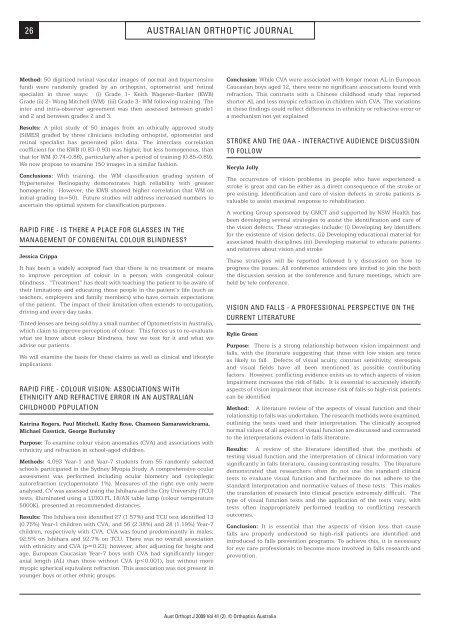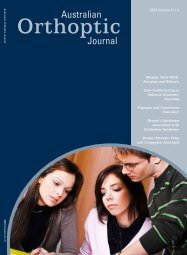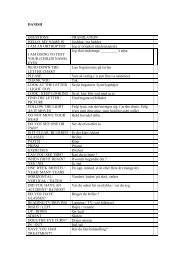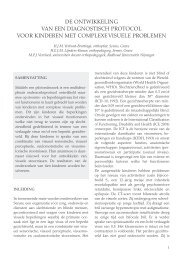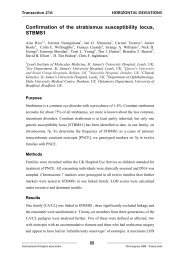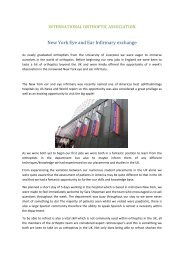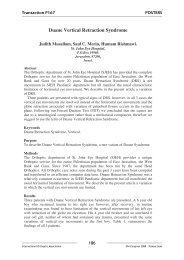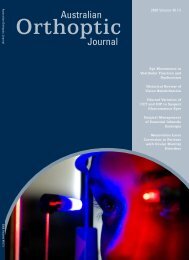Verbal Skills during Patient Consultations Compressive Optic ...
Verbal Skills during Patient Consultations Compressive Optic ...
Verbal Skills during Patient Consultations Compressive Optic ...
You also want an ePaper? Increase the reach of your titles
YUMPU automatically turns print PDFs into web optimized ePapers that Google loves.
26<br />
australian orthoptic journal<br />
Method: 50 digitized retinal vascular images of normal and hypertensive<br />
fundi were randomly graded by an orthoptist, optometrist and retinal<br />
specialist in three ways: (i) Grade 1- Keith Wagener-Barker (KWB)<br />
Grade (ii) 2- Wong Mitchell (WM) (iii) Grade 3- WM following training. The<br />
inter and intra-observer agreement was then assessed between grade1<br />
and 2 and between grades 2 and 3.<br />
Results: A pilot study of 50 images from an ethically approved study<br />
(SiMES) graded by three clinicians including orthoptist, optometrist and<br />
retinal specialist has generated pilot data. The interclass correlation<br />
coefficient for the KWB (0.83-0.93) was higher, but less homogenous, than<br />
that for WM (0.74-0.86), particularly after a period of training (0.85-0.89).<br />
We now propose to examine 150 images in a similar fashion.<br />
Conclusions: With training, the WM classification grading system of<br />
Hypertensive Retinopathy demonstrates high reliability with greater<br />
homogeneity. However, the KWB showed higher correlation that WM on<br />
initial grading (n=50). Future studies will address increased numbers to<br />
ascertain the optimal system for classification purposes.<br />
RAPID FIRE - IS THERE A PLACE FOR GLASSES IN THE<br />
MANAGEMENT OF CONGENITAL COLOUR BLINDNESS<br />
Jessica Crippa<br />
It has been a widely accepted fact that there is no treatment or means<br />
to improve perception of colour in a person with congenital colour<br />
blindness. “Treatment” has dealt with teaching the patient to be aware of<br />
their limitations and educating those people in the patient’s life (such as<br />
teachers, employers and family members) who have certain expectations<br />
of the patient. The impact of their limitation often extends to occupation,<br />
driving and every day tasks.<br />
Tinted lenses are being sold by a small number of Optometrists in Australia,<br />
which claim to improve perception of colour. This forces us to re-evaluate<br />
what we know about colour blindness, how we test for it and what we<br />
advise our patients.<br />
We will examine the basis for these claims as well as clinical and lifestyle<br />
implications.<br />
RAPID FIRE - COLOUR VISION: ASSOCIATIONS WITH<br />
ETHNICITY AND REFRACTIVE ERROR IN AN AUSTRALIAN<br />
CHILDHOOD POPULATION<br />
Katrina Rogers, Paul Mitchell, Kathy Rose, Chameen Samarawickrama,<br />
Michael Cosstick, George Burlutsky<br />
Purpose: To examine colour vision anomalies (CVA) and associations with<br />
ethnicity and refraction in school-aged children.<br />
Methods: 4,093 Year-1 and Year-7 students from 55 randomly selected<br />
schools participated in the Sydney Myopia Study. A comprehensive ocular<br />
assessment was performed including ocular biometry and cycloplegic<br />
autorefraction (cyclopentolate 1%). Measures of the right eye only were<br />
analysed. CV was assessed using the Ishihara and the City University (TCU)<br />
tests, illuminated using a LUXO.FL 18/AN table lamp (colour temperature<br />
5000K), presented at recommended distances.<br />
Results: The Ishihara test identified 27 (1.57%) and TCU test identified 13<br />
(0.75%) Year-1 children with CVA, and 56 (2.38%) and 28 (1.19%) Year-7<br />
children, respectively with CVA. CVA was found predominantly in males:<br />
92.5% on Ishihara and 92.7% on TCU. There was no overall association<br />
with ethnicity and CVA (p=0.23); however, after adjusting for height and<br />
age, European Caucasian Year-7 boys with CVA had significantly longer<br />
axial length (AL) than those without CVA (p


